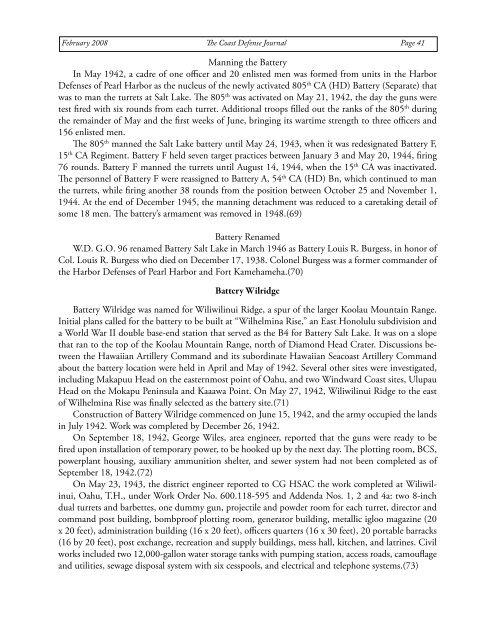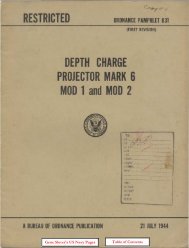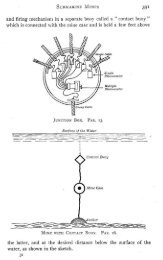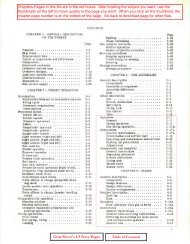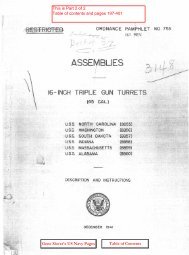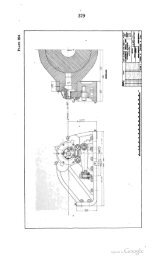Oahu's 8-inch Naval Turret Batteries 1942-1949 - Personal Page of ...
Oahu's 8-inch Naval Turret Batteries 1942-1949 - Personal Page of ...
Oahu's 8-inch Naval Turret Batteries 1942-1949 - Personal Page of ...
You also want an ePaper? Increase the reach of your titles
YUMPU automatically turns print PDFs into web optimized ePapers that Google loves.
February 2008 The Coast Defense Journal <strong>Page</strong> 41<br />
Manning the Battery<br />
In May <strong>1942</strong>, a cadre <strong>of</strong> one <strong>of</strong>ficer and 20 enlisted men was formed from units in the Harbor<br />
Defenses <strong>of</strong> Pearl Harbor as the nucleus <strong>of</strong> the newly activated 805 th CA (HD) Battery (Separate) that<br />
was to man the turrets at Salt Lake. The 805 th was activated on May 21, <strong>1942</strong>, the day the guns were<br />
test fired with six rounds from each turret. Additional troops filled out the ranks <strong>of</strong> the 805 th during<br />
the remainder <strong>of</strong> May and the first weeks <strong>of</strong> June, bringing its wartime strength to three <strong>of</strong>ficers and<br />
156 enlisted men.<br />
The 805 th manned the Salt Lake battery until May 24, 1943, when it was redesignated Battery F,<br />
15 th CA Regiment. Battery F held seven target practices between January 3 and May 20, 1944, firing<br />
76 rounds. Battery F manned the turrets until August 14, 1944, when the 15 th CA was inactivated.<br />
The personnel <strong>of</strong> Battery F were reassigned to Battery A, 54 th CA (HD) Bn, which continued to man<br />
the turrets, while firing another 38 rounds from the position between October 25 and November 1,<br />
1944. At the end <strong>of</strong> December 1945, the manning detachment was reduced to a caretaking detail <strong>of</strong><br />
some 18 men. The battery’s armament was removed in 1948.(69)<br />
Battery Renamed<br />
W.D. G.O. 96 renamed Battery Salt Lake in March 1946 as Battery Louis R. Burgess, in honor <strong>of</strong><br />
Col. Louis R. Burgess who died on December 17, 1938. Colonel Burgess was a former commander <strong>of</strong><br />
the Harbor Defenses <strong>of</strong> Pearl Harbor and Fort Kamehameha.(70)<br />
Battery Wilridge<br />
Battery Wilridge was named for Wiliwilinui Ridge, a spur <strong>of</strong> the larger Koolau Mountain Range.<br />
Initial plans called for the battery to be built at “Wilhelmina Rise,” an East Honolulu subdivision and<br />
a World War II double base-end station that served as the B4 for Battery Salt Lake. It was on a slope<br />
that ran to the top <strong>of</strong> the Koolau Mountain Range, north <strong>of</strong> Diamond Head Crater. Discussions between<br />
the Hawaiian Artillery Command and its subordinate Hawaiian Seacoast Artillery Command<br />
about the battery location were held in April and May <strong>of</strong> <strong>1942</strong>. Several other sites were investigated,<br />
including Makapuu Head on the easternmost point <strong>of</strong> Oahu, and two Windward Coast sites, Ulupau<br />
Head on the Mokapu Peninsula and Kaaawa Point. On May 27, <strong>1942</strong>, Wiliwilinui Ridge to the east<br />
<strong>of</strong> Wilhelmina Rise was finally selected as the battery site.(71)<br />
Construction <strong>of</strong> Battery Wilridge commenced on June 15, <strong>1942</strong>, and the army occupied the lands<br />
in July <strong>1942</strong>. Work was completed by December 26, <strong>1942</strong>.<br />
On September 18, <strong>1942</strong>, George Wiles, area engineer, reported that the guns were ready to be<br />
fired upon installation <strong>of</strong> temporary power, to be hooked up by the next day. The plotting room, BCS,<br />
powerplant housing, auxiliary ammunition shelter, and sewer system had not been completed as <strong>of</strong><br />
September 18, <strong>1942</strong>.(72)<br />
On May 23, 1943, the district engineer reported to CG HSAC the work completed at Wiliwilinui,<br />
Oahu, T.H., under Work Order No. 600.118-595 and Addenda Nos. 1, 2 and 4a: two 8-<strong>inch</strong><br />
dual turrets and barbettes, one dummy gun, projectile and powder room for each turret, director and<br />
command post building, bombpro<strong>of</strong> plotting room, generator building, metallic igloo magazine (20<br />
x 20 feet), administration building (16 x 20 feet), <strong>of</strong>ficers quarters (16 x 30 feet), 20 portable barracks<br />
(16 by 20 feet), post exchange, recreation and supply buildings, mess hall, kitchen, and latrines. Civil<br />
works included two 12,000-gallon water storage tanks with pumping station, access roads, camouflage<br />
and utilities, sewage disposal system with six cesspools, and electrical and telephone systems.(73)


